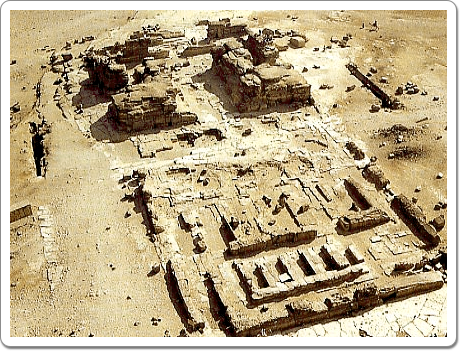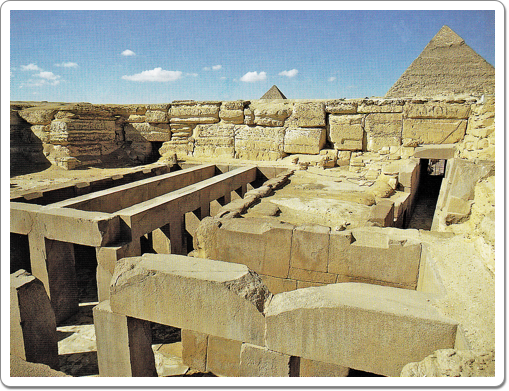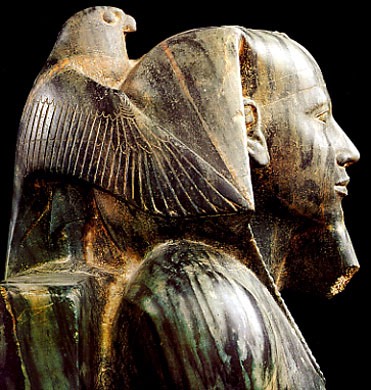Mortuary Temple
Khefren's mortuary temple marks the final transition of the funerary chapels that stood east of the pyramids of Snofru at Dashur, to an actual temple. It is also the first mortuary temple to have incorporated the five features that would become standard for the mortuary temples to come:
- an entrance hall
- a broad columned court
- five niches for statues of the king
- five storage chambers
- an inner sanctuary that housed either a pair of stelae, a false door or both.
The temple consists of a fore part and a back part. The fore part was made of huge blocks of limestone, which were encased in a finer quality of limestone. This technique was yet another innovation that was introduced during the reign of Khefren.

The remains of Khefren's mortuary temple, seen from his pyramid. The distinction between the heavy fore section and the lighter back section is very clear.
Source: Lehner, Complete Pyramids, p. 124.
A 494.6m long causeway that connects it to the Valley Temple, enters the Mortuary Temple near the South end of the East face.The entrance hall consisted of a transversed section near the actual entrance, and a rectangular hall behind it. Both sections had columns to support the roof. A long, narrow chamber branches off at each end of the second hall, perhaps, once housing a statue of the king.The second hall opens into a large open court, surrounded by pillars In front of the pillars there once stood 12 large statues of the king some of which may have been usurped by Ramesses II many centuries later.
Beyond the court there are the now badly damaged five niches for more statues of the king. Behind each niche, there is a storage chamber and at the very back of the temple, against the pyramid itself, there was the actual inner sanctuary that probably contained a false door through which the deceased king could come to collect his daily offerings.
North of the five niches, a corridor leads from the columned court to the pyramid enclosement.
Outside the Mortuary Temple, 5 boat pits and the beginning of a 6th one have been found cut into the bedrock. Two of them still retain their original roofing slabs. Shaped like boats, they once housed the boats that were used to bring the king's mortal remains to his final resting place.
Valley Temple
Like the fore section of the Mortuary Temple, the Valley Temple was built of huge blocks of stone, that were lined with finer blocks.The temple had two entrances, probably symbolising the duality of Upper and Lower Egypt, each connecting to a vestibule, from which a door led to a large hall, shaped like an inverted T. The roof of the hall was supported by 16 single-block granite pillars The walls were covered in red granite and the floor pavements were made of Egyptian alabaster. There are 23 shallow pits in the floor, each once holding a statue of the king. One of the pits is wider than the others and may have held a double-statue, setting the total statues of the king in the Valley Temple to 24. This number has led some Egyptologists to suggest that every hour of the day, a ritual was performed in front of one of the statues.
In the southwest of the transverse part of this hall, there are three additional niches. In the northwest, a corridor leads to the causeway that connects the Valley Temple to the Mortuary Temple.

Khefren's Valley Temple, with his pyramid in the back, to the right.
Source: Lehner, Complete Pyramids, p. 125.
